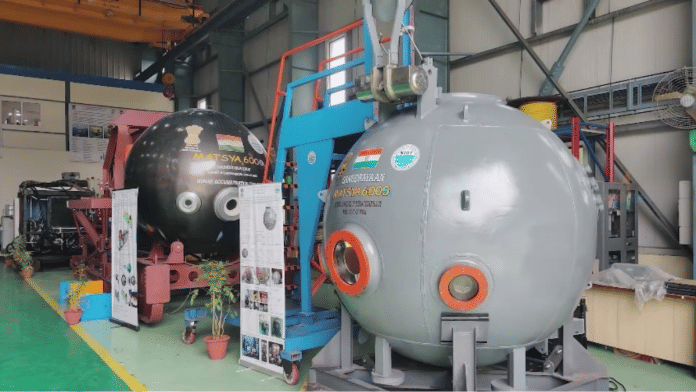New Delhi: India is a step closer to realising its first crewed deep ocean exploration. Scientists from the National Institute of Ocean Technology (NIOT) and the Indian Space Research Organisation (ISRO) completed a critical welding process on the Matsya-6000—the submersible that will carry out India’s ‘Samudrayaan’ mission.
Samudrayaan, which is part of the government’s larger Deep Ocean Mission, will send humans to a depth of 6,000 metres.
This journey into the ocean’s depths will be undertaken in a spherical submersible vessel, the Matsya-6000, which has a diameter of 2,260 mm and a wall thickness of 80 mm. Its titanium-alloy walls can withstand external pressures up to 600 bar and temperatures as low as -3°C.
On Wednesday, ISRO, which is developing this crew capsule, announced that it had completed a key weld for this capsule. This is the first time in India that such a thick titanium alloy sphere was welded. It was done using electron beam welding (EBW) technology, which is typically used for spacecraft and nuclear energy components. This was achieved after nearly 700 trials.
“High-penetration welding of this scale—80 mm weld thickness over a length of 7,100 mm with a 32-minute weld duration—was carried out for the first time in the country,” a statement by ISRO read.
This achievement is significant because it is India’s first-ever human-rated deep-sea weld on a titanium sphere, using advanced space-grade technology.
ThePrint explains how it was done and its significance in achieving the final Samudrayaan mission.
Challenging technology
One of the biggest challenges scientists faced in creating this weld lay in the properties of titanium as a metal. While titanium is known for its strength, it can be difficult to weld.
Its high reactivity with oxygen and nitrogen can cause porosity and embrittlement in the weld.
Another challenge, according to ISRO, was to develop a ‘reliable, high penetration (80-102mm thick) electron beam welding (EBW) process and a high-energy (7.5 (mega-electron volts or MeV) X-ray radiography facility for a non-destructive evaluation (NDE), a method of evaluating the properties of materials, components, or systems without causing damage, which is essential for the certification of the human-rated product.’
Another challenge, according to ISRO, was developing a ‘reliable, high-penetration electron beam welding (EBW) process’ for welds 80–102 mm thick. Additionally, a high-energy X-ray radiography facility with a beam energy of 7.5 mega-electron volts (MeV) had to be established for non-destructive evaluation (NDE), a method of assessing materials or systems without causing damage, essential for certifying the human-rated product.
ISRO’s Liquid Propulsion Systems Centre (LPSC) in Bengaluru developed the process and infrastructure for the welding process and NDE. While the LPSC had the expertise to carry out welding up to 20mm thickness, it augmented the EBW machine from a 15kW rating to 40kW, while also making alterations to the chemical cleaning and handling equipment to accommodate the increased size and mass.
For NDE, the existing X-ray facility in the kV range was augmented to the 7.5 MeV range.
‘Multiple NDE techniques were employed which complement each other in ascertaining weld quality, including Time of Flight Diffraction (TOFD) and Dual Linear Array (DLA) Phased Array Ultrasonic Testing (PAUT),’ the statement read.
Also Read: Rs 600 crore allocated in Budget for Samudrayaan






